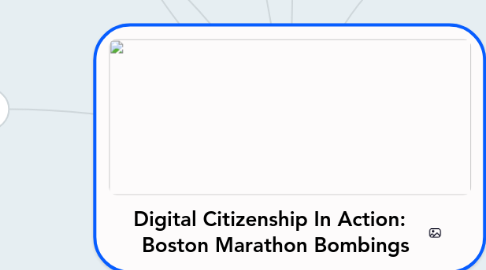
1. What were the following cyber Tools used during and after attack?
2. Reaction of News Media
2.1. Pros
2.1.1. "Lisa Kashinsky, a student covering the marathon for BU News Service, was standing at a window in an apartment building behind the Prudential Center when she heard two back-to-back explosions. She immediately left and headed towards her apartment near Boston University. “When I got to Kenmore, I saw a woman sitting on a bench trying to call someone on their cellphone, crying,” she said. She was one of a team of reporters who were expecting a routine day coving a marathon and instead became a part of the story." -https://diigo.com/0245e9
2.2. Cons
2.2.1. "“I heard the second one and at that point I saw people running away from the Prudential Center food court,” she said. “I saw a couple runners on the track turn around and start running in the other direction.” When she reached the ground, police were directing people away from the Prudential Center and surrounding buildings. While there was confusion, everyone remained notably orderly. “No one was flat-out panicked running,” she said, “but they were worried and hurried. Lots of people were trying to use their cell phones but there wasn’t cell phone service.” Kashinsky reports that text messages also wouldn’t go through immediately and that Green Line T services were shut down by the time she got to Kenmore Station." -https://diigo.com/0245ed
3. Reaction of Social Media
3.1. Pros
3.1.1. "Unable to call all the family and friends who were worried about her, she posted a picture of ambulances clogging a nearby street to let people know she was safe." "When cell phones are jammed up and lines don't work, people can just go on to Instagram, Twitter, whatever and see that picture and know I'm there, I experienced it, but I'm not hurt, I'm all right, " -Rachel Morgan
3.2. Cons
3.2.1. "In an attempt to use the power of online communities, people scrutinized photos and videos of the marathon finish line to find the bombers. They shared their thoughts, their guesses, and their suspicions. The online crowd didn't have the skill or all the tools that law enforcement did, but they had numbers. It seemed as if that might help, but events didn't quite work out that way. Instead innocent people were fingered. A missing student and a pair of friends carrying a backpack and a weighted-down shoulder bag were identified as potential suspects, in one case with photos appearing on the front page of the New York Post. But these individuals had nothing to do with the attacks." -https://diigo.com/0245cq
4. Were the 9 elements of Digital Citizenship applied?
4.1. "Yes and No. Although the general public was trying to help to complete the investigation; in my opinion they actually made it worse. Posting pictures, sharing false information, making assumptions, and tweeting thoughts instead of facts etc... made a huge impact in this tragic event. I could be wrong, but that is just my opinion from the research I have gathered." - Cherish Jesine
5. Resources uSed
5.1. Cover Image: http://topics.bloomberg.com/boston-marathon-bombings/
5.2. http://www.lexisnexis.com.oclc.fullsail.edu:81/lnacui2api/results/docview/docview.do?docLinkInd=true&risb=21_T20426517931&format=GNBFI&sort=BOOLEAN&startDocNo=1&resultsUrlKey=29_T20426517935&cisb=22_T20426517934&treeMax=true&treeWidth=0&csi=397220&docNo=7
5.3. http://www.myfoxboston.com/story/25257252/timeline-of-the-marathon-bombings-preserved-on-social-media
5.4. https://www.diigo.com/list/cherishjesine/Boston+Marathon/3ichjaej4
5.5. http://www.huffingtonpost.com/susan-landau/boston-and-the-right-to-p_b_3135672.html
5.6. http://bunewsservice.com/bu-student-reporter-hears-blast/
6. Reaction of Law Enforcement
6.1. Pros
6.1.1. "Federal Agents" say they know the bombs were made from pressure cookers packed with explosives, nails and other shrapnel, but they still don't know who detonated them or why.
6.2. Cons
6.2.1. On April 18, 2013: "Investigators" release "photographs" and "video" of two suspects and ask for the public's help in identifying them. Later that night, Massachusetts "Institute of Technology" police officer Sean Collier is shot to death in his cruiser, allegedly by Tamerlan and Dzhokhar Tsarnaev.

